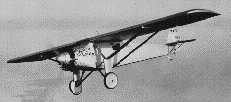
Charles Lindbergh

Charles Lindbergh was an American aviator, which made the first solo nonstop flight across the Atlantic Ocean on May 20-21, 1927. Other pilots had crossed the Atlantic before him. But Lindbergh was the first person to do it alone nonstop. Lindbergh’s feat gained him immediate, international fame. The press named him "Lucky Lindy" and the "Lone Eagle." Americans and Europeans idolized the shy, slim young man and showered him with honors.
Charles Lindbergh was born on February 4, 1902, in Detroit. He grew up on a farm near Little Falls, Minnesota. He was the son of Charles Lindbergh, Sr., a lawyer, and his wife, Evangeline Land Lodge. Lindbergh’s father served as a U.S. congressman from Minnesota from 1907-1917. In childhood, Lindbergh showed exceptional mechanical ability. When he was 18 year old, he entered the University of Wisconsin to study engineering. However, Lindbergh was more interested in the exciting, young field of aviation than he was in school. After two years, he left school to become a barnstormer, a pilot who performed daredevil stunts at fairs.

In 1924, Lindbergh enlisted in the United Sates Army so that he could be trained as an Arm Air Service Reserve pilot. In 1925, he graduated from the Army’s flight-training school at Brooks and Kelly fields, near San Antonio, as the best pilot in his class. After Lindbergh completed his Army training, the Robertson Aircraft Corporation of St. Louis hired him to fly the mail between St. Louis and Chicago. He gained a reputation as a cautious and capable pilot.
In 1919, a New York City hotel owner named Raymond Orteig offered $25,000 to the first aviator to fly nonstop from New York to Paris. Several pilots were killed or injured while competing for the Orteig prize. 1927 had still not won it. Lindbergh believed he could win it if he had the right airplane. He persuaded nine St. Louis businessmen to help him finance the cost of a plane. Lindbergh chose Ryan Aeronautical Company of San Diego to manufacture a special plane, which he helped design. He named the plane the Spirit of St. Louis.

Lindbergh tested the plane by flying from San Diego to New York City with an overnight stop in St. Louis. The flight took 20 hours and 21 minutes, a transcontinental record. On May 20, Lindbergh took off in the Spirit of St. Louis from Roosevelt Field, near New York City, at 7:52 a.m. He landed at Le Bourget field, near Paris, on May 21 at 10:21 p.m. thousands of cheering people had gathered to meet him.

Lindbergh died of cancer on August 26, 1974, in an island off of Hawaii named Maui. Lindbergh’s heroic flight thrilled people throughout the world. He was honored with awards, celebrations, and parades. President Calvin Coolidge gave Lindbergh the Congressional Medal of Honor and the first Distinguished Flying Cross in World history.